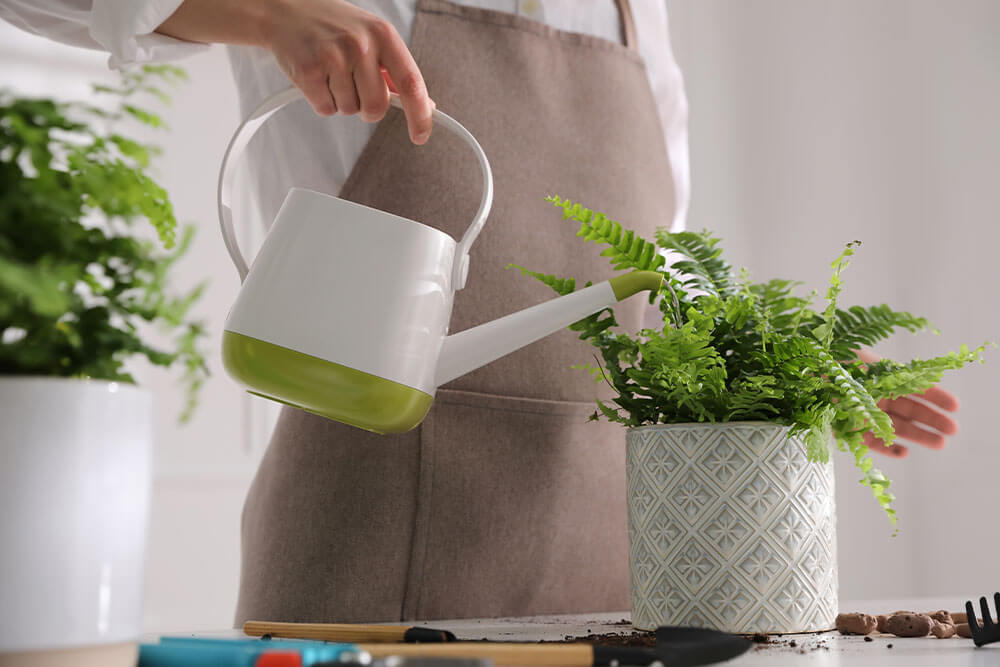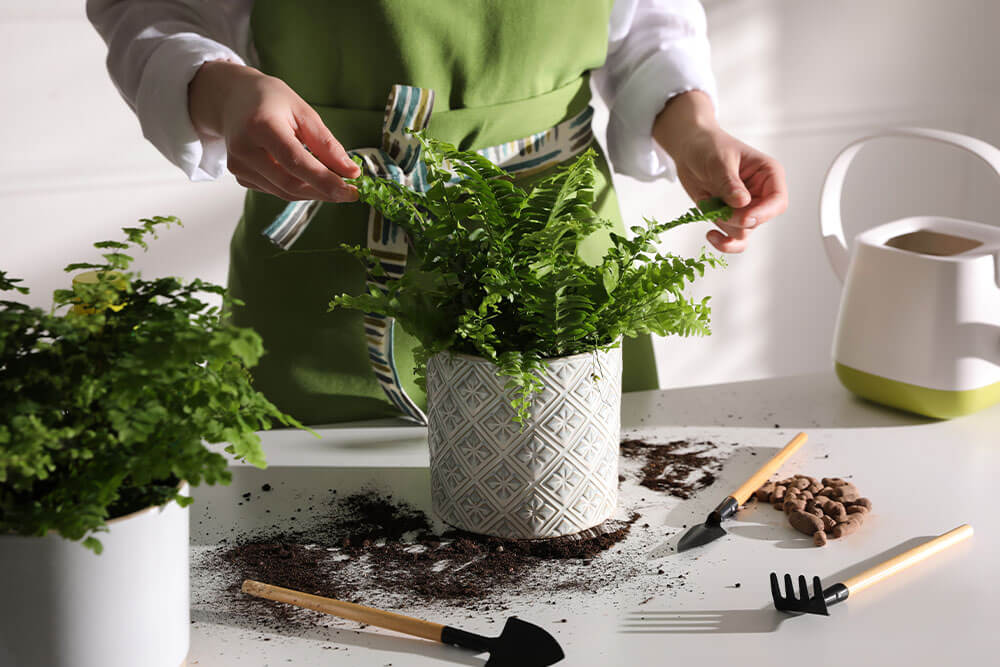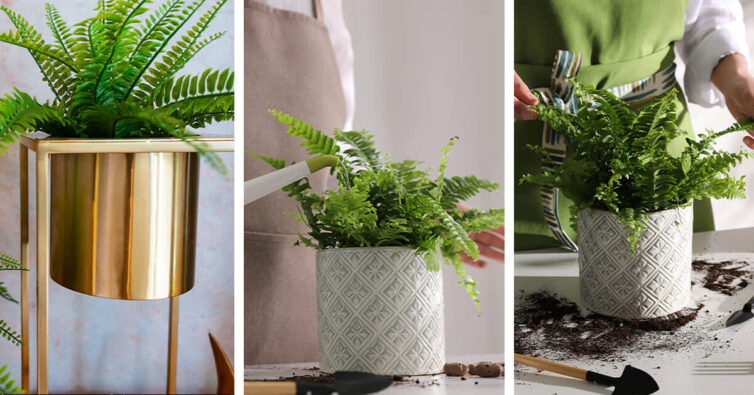Ferns have a reputation for being high maintenance vs. other houseplants. Thankfully, Boston Ferns are among the least tricky regarding needs and care. Once you’ve got the basics of lighting, watering, and humidity, your Boston Fern will thrive.
Boston Fern Findings
If you want a flowering plant, Boston Ferns will not suffice. Rather than blossoming, they produce spores for reproduction. Ferns also have no seeds. They simply send out runners that will root and grow. But as an ornamental plant, the Boston Fern shines.
While being a tropical plant, Boston Fern fares well as an indoor decorative touch. They’ll grow fine in USDA Hardiness Zones 9-11. So while you could grow a Boston fern in a mild climate, it adapts far more readily to indoor container cultivation.
Key Takeaways
- Boston Ferns have graceful, arching fronds that can provide a backdrop to your other indoor plants or water features.
- You can propagate Boston Ferns by taking a runner and putting it into a pot filled with fresh soil.
- These ferns suit advanced beginner gardeners.
- Boston Ferns perform best in sunny exposure areas.
Pet Safe! Those five-foot fronds can tempt a kitty or curious pup. The ASPCA promises they are perfectly safe if ingested by either.
Indoor Boston Fern Care
So what are some strategies to keep your Boston Fern Healthy? For one, you can plant them in regular potting soil. Second, it needs indirect light. A bright kitchen is ideal. It will not survive in the pounding sun. Third, keep the fern’s soil evenly moist.
When considering containers, remember that Boston ferns will grow as much as their container allows. Glazed terra cotta is an excellent material for the pot. When your fern looks a bit scraggly or you find a lot of leaves around it, it’s time to prune. If you have an indoor humidifier, Boston Ferns will benefit from it.
Keeping it Clean: There are a variety of plants proven to improve air quality, including Boston Fern. NASA studies show it removes various toxins from the air, including formaldehyde and xylene. If you place one in your sleeping area, you may find you get more rest because of the improved atmosphere.
What do Boston Ferns Need?

There are four points to focus on when caring for Boston Ferns.
Humidity
Many people don’t realize that Boston Ferns dry out easily. One solution in your home is a small humidifier near the plants. Another is placing the fern in the bathroom or kitchen, the two areas of the house with greater humidity. Mist your fern regularly, and if you plant them near each other, they actually exchange humidity!
Fertilizer
During peak growing periods, the fronds on Boston Ferns may grow lackluster. So this is an excellent time to apply fertilizer. Look for a 20-10-20 mixture.
Light
You want to get the lighting “just right” to keep your Boston fern healthy. In nature, ferns grow under the cover of tall trees to shade them from direct sunlight. So, you want to mirror that partial lighting in your home. 70 degrees makes your plant happy (some windows increase the heat with the light).
Water
“Wet” is not a word in the Boston Fern’s vocabulary. Your plant thrives in moist soil, being watered approximately every 7-10 days. If there’s excess water in the pot that does not drip out, empty it to avoid root rot.
Belonging to the fern family gives the Boston Fern a long family tree stretching 450 million years. In fact, this plant ranks among the oldest plants on earth. Boston Fern existed this long, thanks to adaptability.
Shopping for Indoor Boston Ferns
There are over 50 cultivars of the Boston Fern, giving you a nice array from which to choose.
- Compacta: As the name implies, Compacta is a small, tight bush measuring 36” high and 4” wide at maturity. Fronds make a very symmetrical look.
- Dallas (Dallas Jewel) is a Boston Fern that can tolerate dimmer lighting. In your home, it’s not overly picky. The fronds have a ruffled appearance, with a fine texture and arching foliage. In its youth, the leaves emerge as light grass green, eventually turning to forest green. Mature height 24-36 inches tall and 24 inches wide.
- Florida Ruffle: Twice-divided leaflets make the Florida Ruffle look like it’s adorned with feathers. This is a taller Boston Fern, growing 5 feet tall and 6 inches wide. The pictures of Victorian homes often featured this fern.
- Fluffy Duffy (buy it just for the cute name): A feathery, dense fern featuring divided fronds that overlap, creating density. Height at maturity is no more than 12-24 inches in height and with, making it uniform.
Fluffy Duffy has a smaller brother with wavy leaflets growing densely. It is a dwarf cultivar, unlikely to get over 12 inches tall at maturity. Its size makes it a great window sill plant. - Golden Boston: This pretty fern has a yellow tint to its fronds. One fern in this category, “Rita’s Gold,” keeps its sunny disposition throughout the growing season, seeming to glow. It’s smaller than the Golden Boston measurements (18-24 inches.) Rita grows a dainty 7 inches tall.
- Massii: A pretty fern with dark green ferns and free-swinging fronds. In favorable conditions, it grows 24” tall and 48. inches wide. It is often mistaken for the Asian Sword Fern.
- Rooseveltii: This fern boasts finely cut fronds, some of which crest at the end. Roosevelt’s leaves measure 3 feet. Suggested for hanging baskets.
- Verona: This fern has lacy fronds suitable for an heirloom plant. This Victorian parlor plant is graceful. The fronds measure 6 lunches wide by 5 feet long. Feed Verona once a month.
Lucky Ferns: In some cultures, people believe Boston Ferns bring prosperity and good fortune. It also represents sincerity. Boston Ferns aren’t the only ones that have symbolic value. For example, the Maidenhair fern stands for secret love and the Staghorn fern – for persistence. Ostrich fern is an emblem of magic and unending possibilities, while Asparagus ferns mean friendship.
Thirsty Indoor Boston Ferns

Boston Ferns dance when water comes. They simply love it. It’s a good idea to check your baskets and pots weekly. If the container feels lighter than usual, your plant is dry. The converse is true. If it feels heavy, hold off. Think moderation in your watering rituals.
Avoid watering ferns from above. Direct your irrigation to the bottom of the plant. From there, it trickles down into the roots. By the way, filtered water is best for your indoor Boston Fern (at room temperature, please). Tap water often contains particles unhealthy for your fern.
From South America to the World: The Boston Fern grew in South America, Mexico, and the West Indies. The first adventure for your plant was gathering with 199 more ferns on a trip from Philadelphia to Boston in 1894. F.C. Becker, a florist, upon reviewing his shipment, saw a fast-growing fern with wider fronds and flexible leaves. He began propagating it immediately. By 1896, the suggestion came forward to name this variant “Boston,” and it stuck.
Planting, Potting, and Repotting

Once you know the basics of planting, potting, and repotting come naturally. They’re really all the same, but for when they take place.
A key factor in planting Boston Ferns is moisture management. Buy only containers with excellent drainage. Use basic potting soil and fill up your crock about ⅓ of the way.
If you’ve just received it or brought it home from the nursery, gently remove it from the original container and shake out the soil. Fill your chosen pot ⅓ full. Place the fern in the middle. Pour more soil around it until it reaches about 1 inch below the rim. Give it a good watering in your sink. Let it drain off before moving it to a new home.
Not sure if your Boston Fen needs repotting? If the plant’s growth slows, that’s one sign. Look at the drainage holes. You will likely see roots sticking out, looking for room. Find a new container about 2 inches larger than the current one, and follow the same process as for planting, but for one thing. You want to sow the fern at the same depth as in the previous container. Give the soil a light pat, and ensure the area you’ve chosen for the fern has indirect lighting.
While some Boston Ferns grow up to five feet, the average size is 2 feet high by 2 feet wide. That evenness is one of the reasons Boston Ferns are so appealing to the eye. Plants that don’t meet your expectations may have problems. The soil may need amendment, it might be receiving too little (or too much) sun and water, or you may have diseases or pests. Give your fern a good once over, using a magnifying glass. If you notice something odd, search further.
Indoor Boston Fern: Pruning and Maintenance
Pruning is a very light duty for Boston Ferns. You need to remove yellow, brown, or dead fronds or unsightly areas, but that’s about it. You can accomplish this when you repot (let’s hear it for multitasking). If you’re thinking of a dramatic cutback, this is the time. Boston Ferns respond well to pruning, becoming bushier.
Boston Fern vs. the Sword Fern: It is not uncommon to think of Boston Ferns and Sword Ferns as the same plant. They’re not. Sword ferns have over 250 species; Boston fern has 30+ cultivars. The leaves of Sword Ferns measure five feet long, looking much like blades. Boston Fern has six-inch wide leaves that are somewhat frilly.
Blooming and Resting Periods
Since the Boston Fern is without flowers, you don’t have to worry about blooming. However, you may think your plant has gone dormant at times. If it’s not getting enough humidity, the fronds dry and become brown.
You can reverse this, but you’ll lose a few fronds in the process. Being an evergreen, Boston Ferns do not have a natural period of dormancy. Their yearly care is consistently the same.
They require their care, watering, and feeding to remain the same throughout the year.
You can get quite an impactful indoor landscape by bundling Blue Star Ferns and Asparagus Fern near each other. Or. you can add some type of perennial for a pop of color. So where do you put them around your home?
Pedestals at the base of railings look dramatic. Add them to one side of a pass-through. Sneak them onto bookshelves, or hang them in areas where a little green will help brighten things. If you plant your Boston Ferns in small pots or hangers, you can always take them out for some partial summer sun.
Battling Boston Fern Pests & Diseases
Being indoors protects your ferns from some pests and diseases, but not all. Every time you bring another plant into the home, they could harbor hitchhikers in their leaves or soil. With Boston Ferns, caterpillars create holes the the edges of the leaves. This could be confused with slugs. Pick them off if you see them, and treat your plant with Bonide Thuricide.
Fungus gnats create much less damage than their kids. These insects don’t fly well, so you may see them flitting from frond to frond, so they’re annoying. Their larvae, on the other hand, nestle in the soil and go after the lower stems and roots. Clean out the plant of all the soil and get it freshed. Treat the surface of the soil with sprays for controlling larvae.
Mealybugs seem to show up in any examination of indoor plants. These little cotton balls live on the lower leaves and roots, resulting in sooty mold. This stunts the plant growth. You’ll need to drench your soil with an insecticide. Make sure your pots have good drainage.
Root Rot happens in Bost Ferns getting too much water. The plant grows slowly. Fronds wilt, yellow, and gray. Remove your plant from the media. Shake off any clinging dirt. Replace it into a pathogen free media, and take care with your watering.
Rhizoctonia aerial blight begins in the soil. The outward appearances include brown lesions in the foliage, and a damp crown accompanied by lesions. You can treat this much like pythium root rot by completely changing the soil and ridding the plants of diseased parts.
There is a theory that putting certain crystals into the soil, or around your Boston Fern, help it energetically. Different stones do different things:
- Amethyst: Plant purification
- Citrine: Improved vitamin D for the plant
- Clear Quartz: for fertile soil
- Green Aventuring: Ongoing vitality
- Green Calcite: For an energy boost
- Moonstone: Deep root
- Pirite: For stamina during difficult environmental changes
- Rose Quartz: for positive energy around the plant
- Tiger’s eye: for abundant growth
- Tourmaline: Bringing sick plants back to health
Troubleshooting Common Boston Fern Problems
- Yellowing Leaves: This is the first sign of over-watering. If the soil seems soggy, let the excess water drain out and leave it to dry. Trim away the yellowed or browned leaves.
- Brown-ended leaves: You probably have your fern in an area with too much direct sun, so just move it. Alternatively, your plant may need more water (the leaves may look gray).
- Falling leaves: As the fern ages, it’s normal for older leaves to fall off. This makes room for new growth.
Runner burn: Salt is one culprit. Use better quality water.
Summary
Boston ferns are not overly difficult to care for, but a person needs a little experience to be successful. They make fantastic additions to indoor gardens and create a more natural feel to your home. Not all ferns are created equal, so take a little time to investigate which one you want as a happy addition.


